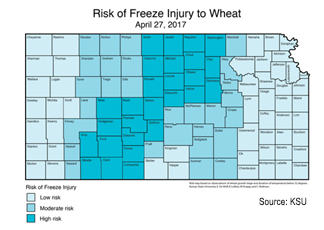Markets jumped with post-storm assessments like the one tweeted by Kansas Wheat Grower CEO Justin Gilpin: “We lost the western Kansas wheat crop this weekend.” While still shy of the nearly $5 mid-February price that followed expectations of a century low for wheat acreage, markets rallied 25 cents between April 28 and May 2 – rising from $4.40 to nearly $4.75.
Actual yield loss won’t be known until harvest, and even physical signs of damage to plants can take a week to 10 days to show – after growth has a chance to resume, according to Romulo Lollato, Kansas State University Extension specialist for wheat and forages. But the potential for loss certainly exists: In general, temperatures below 32˚F for two hours or more will cause damage.
USDA’s most recent Crop Progress report adds to the likelihood of damage. Forty-four percent of the Kansas crop was headed as of April 30, well ahead of the five-year average of 33 percent. Jointing also is ahead of normal. Freezing during heading and flowering can have severe consequences on yield, Lollato said.
KSU agronomists mapped the areas where the wheat crop is more likely to see cold-related damage, taking into account both temperature and crop stage. These included portions of southwest, central and north-central Kansas. The risk of freeze damage is moderate in south-central Kansas and portions of northwest Kansas, based on the temperature and crop stage. The risk of freeze injury in the remainder of the state is lower. Click to view the full report.
 However, the agronomists remind, the risk of freeze damage is field-specific and depends on several microclimate factors:
However, the agronomists remind, the risk of freeze damage is field-specific and depends on several microclimate factors:
- Low areas in fields might experience colder temperatures than those reported at nearby weather stations.
- Increased wind speed can help warmer air make its way into the canopy, decreasing freeze injury potential and vice versa.
- Warm soils, encouraged by good soil moisture, can provide a buffer against cold temperatures experienced in certain fields.
Brett Thornton, an insurance officer in Frontier Farm Credit’s Parsons office, confirmed that area’s crop seems to have been spared.
“At this point, I would say our wheat is looking good, although it may be shorter than normal.” He added that effects of excess moisture have not yet been assessed.
Ratings
As of April 30, USDA had rated 6 percent of the Kansas wheat crop excellent, 43 percent good, 35 percent fair and 16 percent poor or very poor. For the 18 states that planted 90 percent of the 2016 winter wheat acreage, 54 percent was rated good/excellent and 13 percent poor/very poor – slightly better than Kansas’ ratings.
The 2017 crop condition has worsened since last fall, but remained close to last year’s level through the end of April, as shown in the chart below.

The Wheat Quality Council’s annual Kansas Wheat Tour is underway this week, and scouts report a wide range of conditions, with some fields estimated to average as high as 70 bu./acre. Photos capture a range of field conditions, depending on the location -- heavy snow, standing water, the lush green of wheat. Follow the tour on Twitter at #wheattour17.
Bottom line: When the tour ends this week, the market will have a little better idea of wheat conditions in Kansas, and whether high-quality hard red winter wheat will carry a premium. With overall acreage down so much, this year’s crop carries more weight than in surplus years.

